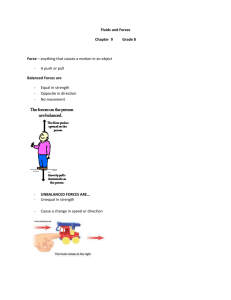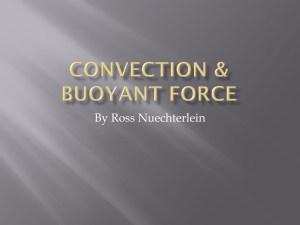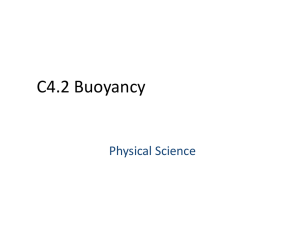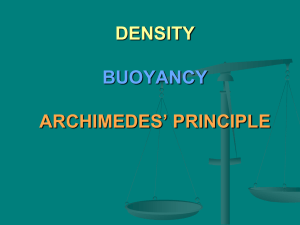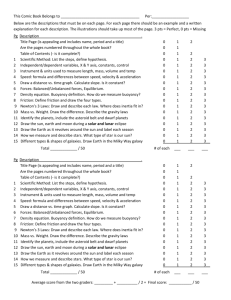Numerical study of MHD free convection in an inclined square
advertisement
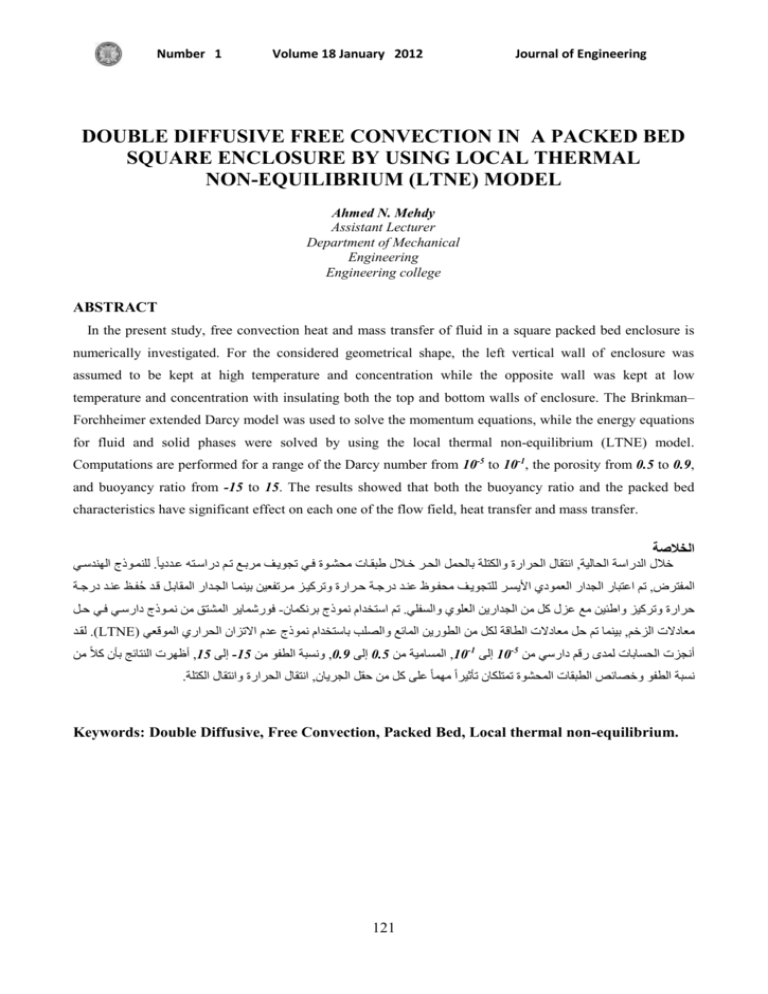
Number 1 Volume 18 January 2012 Journal of Engineering DOUBLE DIFFUSIVE FREE CONVECTION IN A PACKED BED SQUARE ENCLOSURE BY USING LOCAL THERMAL NON-EQUILIBRIUM (LTNE) MODEL Ahmed N. Mehdy Assistant Lecturer Department of Mechanical Engineering Engineering college University of Kufa, Najaf, Iraq ABSTRACT In the present study, free convection heat and mass transfer of fluid in a square packed bed enclosure is numerically investigated. For the considered geometrical shape, the left vertical wall of enclosure was assumed to be kept at high temperature and concentration while the opposite wall was kept at low temperature and concentration with insulating both the top and bottom walls of enclosure. The Brinkman– Forchheimer extended Darcy model was used to solve the momentum equations, while the energy equations for fluid and solid phases were solved by using the local thermal non-equilibrium (LTNE) model. Computations are performed for a range of the Darcy number from 10-5 to 10-1, the porosity from 0.5 to 0.9, and buoyancy ratio from -15 to 15. The results showed that both the buoyancy ratio and the packed bed characteristics have significant effect on each one of the flow field, heat transfer and mass transfer. الخالصة للنمر ج الهندسر.حربر تر رراسرتع دردريا انتقال الحرارة والكتلة بالحمل الحرر خرالل طبقرا ححور ة ر تج ير,خالل الدراسة الحالية ححفر ع دنرد ررحرة ةررارة وتركير حررتفعين بينمرا الجردار المقابرل قرد فةفرع دنرد ررحرة ر ةرل ت ادتبار الجدار العم ري األيسرر للتج ير,المفترض رشماير الموتق حن نمر ج رارسر- ت استخدام نم ج برنكمان. ةرارة وتركي واطئين ح د ل كل حن الجدارين العل ي والسفل لقرد.(LTNE) بينما ت ةل حعارال الطاقة لكل حن الط رين المائ والصلب باستخدام نم ج ددم االت ان الحراري الم قع, حعارال ال خ أعهر النتائج بأن كال حن,15 إلى-15 ونسبة الطف حن,0.9 إلى0.5 المساحية حن,10-1 إلى10-5 الحسابا لمدى رق رارس حن أنج . انتقال الحرارة وانتقال الكتلة,نسبة الطف وخصائص الطبقا المحو ة تمتلكان تأثيرا حهما دلى كل حن ةقل الجريان Keywords: Double Diffusive, Free Convection, Packed Bed, Local thermal non-equilibrium. 121 DOUBLE DIFFUSIVE FREE CONVECTION IN A PACKED BED SQUARE ENCLOSURE BY USING LOCAL THERMAL NON-EQUILIBRIUM (LTNE) MODEL Ahmed N. Mehdy buoyancy forces is necessary in order to control INTRODUCTION Double-diffusive convection or thermosolutal these processes. (Chaudhary and Jain, 2007) convection is generally referred to a fluid flow studied the MHD flow past an infinite vertical generated by buoyancy effects due to both oscillating plate through porous medium with the temperature and solutal concentration gradients. presence of free convection and mass transfer This type of flow is encountered in natural and analytically technological applications. Such applications technique. include the growth of crystals, solar energy double-diffusive convection-radiation interaction systems, welding processes, thermal insulations. for the unsteady MHD flow over a semi-infinite by using Laplace-transform (Mohamed, 2009) analyzed the The term double diffusive-convection is now vertical moving porous plate embedded in a widely accepted for all processes which involve porous medium in the presence of thermal & simultaneous thermal and solutal concentration solutal diffusion and heat generation. A numerical gradients and provides an explanation for a study of the unsteady free convection and mass number of natural phenomena. Because of the transfer flow of an electrically conducting fluid coupling between the fluid velocity field and the past an infinite vertical porous plate in the diffusive (thermal and solutal concentration) presence of a transverse magnetic field was fields, more presented by (Shariful et. al. , 2005). (Bukhari, complex than the convection flow which is 2003) applied a linear stability analysis, using the associated with a single diffusive scalar, and many spectral Chebyshev polynomial method, to obtain different behaviours may be expected. Such numerically the solution of a multi-layer system double-diffusive processes occur in many fields, consisting of the finger convection onset in a fluid including chemical engineering (drying, cleaning layer overlying a porous layer. (Saha and operations, condensation, Hossain, 2004) studied numerically the laminar sublimation, deposition of thin films, energy doubly diffusive free convection flows along an storage in solar ponds, roll-over in storage tanks isothermal vertical finite plate immersed in a containing liquefied natural gas, solution mining stable thermally stratified fluid by using an of salt caverns for crude oil storage, casting of implicit finite difference method and local non- metal alloys and photosynthesis), oceanography similarity method. (Hajri et. al. , 2007) presented (melting and cooling near ice surfaces, sea water a numerical simulation for the steady double- intrusion into freshwater lakes and the formation diffusive natural convection in a triangular cavity of during by using equal finite elements method. A crystallisation of igneous intrusions in earth's numerical study was presented from (Mamou et. crust), geophysics (dispersion of dissolvent al. , 2001) for the unsteady double-diffusive materials or particulate matter in flows), etc. A convection in a two-dimensional horizontal clear understanding of the nature of the interaction confined enclosure by using the finite element between thermal and mass or solutal concentration technique. (Masuda et. al. , 2002) presented a double-diffusive layered convection is evaporations, or columnar structures numerical simulation by using finite differences 122 Number 1 Volume 18 January 2012 Journal of Engineering method for the unsteady two-dimensional double- MATHEMATICAL MODEL diffusive Geometrical Shape of Studied Problem convection in porous rectangular enclosure. After that, (Masuda et. al. , 2008)s The schematic view of the studied problem is studied the peculiar oscillating convection which shown in Fig.1. The square enclosure has a side is double- length (a) and it is filled with a saturated packed diffusive convection in porous medium is bed. The left vertical wall of the square enclosure analyzed numerically. (Khanafer and Vafai, is kept at high temperature and concentration 2002) presented a numerical study of mixed- while the opposite wall is kept at low temperature convection heat and mass transport in a lid-driven and concentration, finally, the horizontal walls are square enclosure filled with a non-Darcian fluid- insulated. observed when two-dimensional saturated porous medium by using the finite volumes technique. (Rahli and Bouhadef, 2004) Governing Equations studied numerically the double-diffusive natural In the model development, the following convection in a partially porous square enclosure assumptions are adopted; the working fluid has a with the presence of inclination effect by using the Prandtl number Pr=0.71 and assumed to be control volume method and the power law incompressible and Newtonian fluid, no phase scheme. (Wang et. al., 2007) presented a change occurs and the process is in a steady state, numerical investigation of natural convection of the thermo physical properties of the fluid are fluid (without mass transfer) in an inclined square assumed to be constant except the density enclosure variation in the buoyancy force, which is filled with porous medium and submitted to a strong magnetic field by using approximated according to the Boussinesq (LTNE) model. However, the buoyancy force due approximation. This variation, due to both to the double-diffusive effect has received more temperature and solutal concentration gradients attention in the literature. But all the previous can be described as follow (Khanafer and Vafai, studies which deal with the double-diffusive 2002); 0 1 T T TL C c cL convection in porous mediums assume that the (1) porous medium in thermo dynamical equilibrium Where βT and βC are the coefficients of the with the fluid which flow inside it, except (Wang thermal and solutal expansions, which are defined et. al., 2007) which studied the pure convection as follow (Khanafer and Vafai, 2002); without mass transfer in the presence of heat T transfer between the fluid and the porous media. The present study gives more attention to the 1 & 0 T p, c 1 C 0 c p,T interaction between the effect of the double- (2) diffusive convection and the effect of heat transfer The Brinkman–Forchheimer extended Darcy between the porous medium and the fluid which model is used to solve the momentum equations flows inside it. while the energy equations for fluid and solid phases are solved with the local thermal non- 123 DOUBLE DIFFUSIVE FREE CONVECTION IN A PACKED BED SQUARE ENCLOSURE BY USING LOCAL THERMAL NON-EQUILIBRIUM (LTNE) MODEL Ahmed N. Mehdy equilibrium (LTNE) model. Thus, the governing F equations for the present study will take the following forms as in (Amiri and Vafai, 1998) a sf and (Khanafer and Vafai, 2002); (9.a ) 150 3 6 (1 ) dp (9.b) 0.6 u d p f hsf k f 2 1.1 Pr 1 3 f - Continuity equation u v 0 x y 1.75 (3) (9.c) - Momentum equations f u u u v 2 x y p f x where the sphere particle diameter dp can be computed as follow (Amiri and Vafai, 1998); (4) F f u u 2u 2u f 2 2 u K x y K d p (1 ) 150 K (9.d ) 3 while the effective thermal conductivity kfeff and kseff in fluid and solid phase energy equations and the mean thermal diffusivity αm can be computed as follow (Wang et. al. , 2007); (5) - Fluid phase energy equation T f T f f cp f u v y x 2T f 2T f k feff x 2 y 2 a sf hsf Ts T f k seff (1 ) k s (10.b) Now k feff k seff we f cp f introduce the (10.c ) following non- dimensional quantities and parameters as in (Khanafer and Vafai, 2002) and (Wang et. al. , 2007); - Solid phase energy equation a sf hsf T f Ts 0 (7) - Solutal concentration equation 2c 2c c c u v D 2 2 x y y x (10.a ) m (6) 2T 2Ts k seff 2s y 2 x k feff k f (8) The geometric function F, specific surface area of the packed bed asf and the fluid-to-solid heat transfer coefficient in a packed bed hsf are determined as suggested by (Amiri and Vafai, 1998); 124 Number 1 x y , Y a a au av U , V X m P f s m p a2 f m 2 (T f TL ) (TH TL ) (Ts TL ) , (TH TL ) (c c L ) C (c H c L ) f cp f , Volume 18 January 2012 1 V V U V 2 Y X P Pr 2V 2V Y X 2 Y 2 , FUV Pr V Da Da 1 U X f Y 1 f f 2 f X 2 Y 2 2 Pr k feff k seff 3 g a T (TH TL ) , GrT 2f g a 3 C (c H c L ) GrC , 2 f f K Da 2 , Sc D a C (c H c L ) GrC N , T (TH TL ) GrT k feff a sf hsf a 2 , k seff k feff ( s f ) 2 s 2 s 0 2 Y 2 X U ( f s ) (16) C C Pr 2 C 2 C V X Y Sc X 2 Y 2 (17) By using the (stream function-vorticity) formulation we will reduce the dependent variables to only five variables by differentiating eq.(13) with respect to (Y) and differentiating eq.(14) with respect to (X), after that we subtract the first of the two resulted equations from the second to eliminate the pressure terms from the momentum equations, thus, eqs.(12, 13 & 14) will be transformed to the following equations; (11.b) 2 2 X 2 Y 2 U V X Y 2 2 Pr 2 2 X Y 5, 6, 7 & 8), we get the dimensionless forms of governing equations as follow; (12) V (14) (15) By substituting eqs.(11.a & 11.b) in eqs.(3, 4, U V 0 X Y Pr 2 GrT f N C (11.a ) f m 1 U U U V 2 Y X P Pr 2U 2U X X 2 Y 2 Journal of Engineering 2 f Pr GrT X 2 Pr F U Da Da (13) FUU Pr U Da Da 125 (17) (18) U F U U V Y Da X N C X DOUBLE DIFFUSIVE FREE CONVECTION IN A PACKED BED SQUARE ENCLOSURE BY USING LOCAL THERMAL NON-EQUILIBRIUM (LTNE) MODEL Ahmed N. Mehdy where ψ and ω are the (stream function & NUMERICAL SOLUTION The governing equations for ψ, ω, θf, θs & C vorticity) respectively, and they are defined as can be written in a common form for the follow; (convection-diffusion) &V Y X V U X Y U (19.a ) (19.b) variables in the flow field, calculations will be made for local and mean Nusselt and Sherwood C X ui X i X i S ( 22) diffusion coeffecient Γ and the source term S in et. al. , 2007) and (Khanafer and Vafai, 2002); Shl X i the dependent variables under consideration, the numbers at the hot wall can be found as in (Wang X 0 follow where the general scalar Φ stands for any one of numbers, where the local Nusselt and Sherwood 1 s X X 0 as (Versteeg and Malalasekera, 1995); After getting the final values of all dependent f Nul X problem the cartesian form are listed below for each governing equation; (20.a) - Stream function equation , 1, S (20.b) (23.a) X 0 - Vorticity equation , Pr , S Boundary Conditions 2 f C N Pr GrT X X 2 Pr F U Da Da The hydrodynamic boundary conditions for the present problem at all enclosure walls will obey to the non-slip condition, while the thermal and solutal boundary conditions are (the left side wall was kept at high temperature and solutal U F U V X U Y Da concentration, the right side wall was kept at low temperature and solutal concentration and finally each one of the top and bottom walls were kept insulated), thus the boundary conditions will be as - Fluid phase energy equation follow; f , U 0, V 0, f s C 1 at X 0 ; U 0, V 0, f s C 0 at X 1; f s C U 0, V 0, 0 Y Y Y at Y 0 & 1 (23.b) ( s f ) 1 ,S 1 1 1 1 (23.c) - Solid phase energy equation (21) s , 1, S ( f s ) (23.d ) - Solutal concentration equation C , 126 Pr , S 0 Sc ( 23.e) Number 1 Volume 18 January 2012 The numerical solution of the governing Journal of Engineering - Solid phase energy equation Su f S p equations will be made according to the finite volume method to transform the governing equations from partial differential form to discrete ( 26.d ) - Solutal concentration equation algebraic form, this method is based on principle elements, each one of them is called (control Su 0 Sp 0 volume), after that a discretization process A computational program was written in (Versteeg and Malalasekera, 1995) was carried Fortran-90 language to compute the values of the out by integrating eq.(22) (of the general required variables, The discretized algebraic conservation) over a control volume element, equations are solved by the tri-diagonal matrix where this equation will be as follow; algorithm (TDMA). The used mesh size is of dividing the flow field to a number of volume a P P a E E aW W a N N aS S S u ( 26.e) (60×60). Relaxation factors of about (0.7–0.9) are (24) used for all dependent variables, Convergence was measured in terms of the maximum change in where; aP aE aW aN aS S P each variable during an iteration where the (25) maximum change allowed for convergence check was 10-6. the source coefficients Su and Sp represent the source terms of the discrete equation and their RESULTS AND DISCUSSION values for each governing equation are listed as All solution were carried out for solution of follow; (Pr=0.71 & Sc=0.25) at GrT= 105, where the - For the stream function equation Su Sp numerical code which is used in the present 0 ( 26.a ) investigation has been carried out for number of simulations for a wide range of controlling - For the vorticity equation 2 f Pr GrT X 2 Su F U V Da X FU 2 Pr S p Da Da C N X U U Y parameters such as buoyancy ratio, Darcy number, and porosity of the packed bed. Figs.(2 - 9) show the effect of buoyancy ratio for different values of (-15≤N≤15) on the stream function, fluid phase (26.b) temperature and solutal concentration contours respectively at Da=10-1 and ε=0.9. Figs.[(2.a), (2.b) & (2.c)] represent these contours for the case of single diffusing effect at N=0, where there is only thermal diffusing without solutal diffusing. It is clear from the stream function contour at N=0 - Fluid phase energy equation Su Sp and as a result of the thermal buoyancy effect, the s 1 1 1 1 fluid at the left-hand side hot wall will be lighter ( 26.c ) than in other locations while the fluid at the righthand side cold wall will be heavier than in other locations, so, the fluid particles move upward 127 Ahmed N. Mehdy DOUBLE DIFFUSIVE FREE CONVECTION IN A PACKED BED SQUARE ENCLOSURE BY USING LOCAL THERMAL NON-EQUILIBRIUM (LTNE) MODEL along the hot wall while they move downward fluid density will increase with increase of the along the cold wall, and thus, the flow will take solutal concentration, and as a result, the flow the direction of clockwise. The fluid phase begins to reverse its direction, So, the flow case at temperature contour at N=0 indicates that the N=-1 as it is shown in Figs.[(6.a), (6.b) & (6.c)] temperature levels will decrease gradually from represents a conversion point in the flow direction the hot wall towards the cold wall, where the hot from clockwise to counterclockwise as it is shown fluid rises up along the left-hand side hot wall and from the stream function distribution at N=-1, descends along the right-hand side cold wall where the clockwise main central vortex which because of the thermal buoyancy effect. Finally formed at each of the previous cases of positive the solutal concentration contour at N=0 indicates buoyancy ratio will divide into two main vortices that the solutal concentration will be maximum at in two opposite directions, also the distribution of the hot regions and decreases gradually with the both the fluid phase temperature and the solutal decrease of the fluid phase temperature. After concentration at N=-1 will begin to change their that, and with increasing the positive buoyancy directions and their gradient will be at the ratio N>0 as shown in Figs.(3, 4 & 5) which minimum levels at this case. With increasing the represent the cases at N=5, 10 & 15, and as it is value of negative buoyancy ratio as it is shown in clear from these figures, the solutal buoyancy Figs.[(7.a), (7.b) & (7.c)] which represent the force which increases with the buoyancy ratio will flow case at N=-5, the negative solutal buoyancy cooperate with the thermal buoyancy and they'll effect will be greater than the thermal buoyancy drive the flow in the same direction to form a effect, and as a result of the total negative cooperator flow, where the stream function levels buoyancy effect, the fluid at the hot wall will be will increase with increasing in positive buoyancy heavier than it in other locations while the fluid at ratio because of the increase of the total buoyancy the cold wall will be lighter than it in other force due to both the thermal and solutal locations, so, the fluid particles move downwards diffusing, while as it is shown from the contours along the hot wall while they move upwards along of fluid phase temperature, its distribution will the cold wall, and thus, the flow will take the keep on the same previous behavior, but the direction of counterclockwise. The fluid phase gradients will be stronger than them at N=0 and temperature contour at N=-5 indicates that the increase directly with increase of the buoyancy temperature levels will decrease gradually from ratio, also a similar behavior to the fluid the hot wall towards the cold wall, where the hot temperature distribution will appear in the fluid descends downwards along the hot wall and contours of the solutal concentration, but their rises up along the cold wall because of the large gradients will be relatively less than the gradients negative effect of solutal buoyancy. Finally the of the fluid phase contours because of the absence solutal concentration contour at N=-5 indicates of internal transference sources as it is clear from that the solutal concentration will be maximum at eq.(23.e). Figs.(6, 7, 8, 9) the cases of negative the hot regions and decreases gradually with the buoyancy ratio N<0, where the negative value of decrease of the fluid phase temperature. Figs.(8 & buoyancy ratio means that the value of solutal 9) represent the flow case at N=-10 & -15 expansion coefficient βC is negative too, and as it respectively, and as it is clear that the levels of is clear from the density definition in eq.(1), the counterclockwise stream function will increase 128 Number 1 Volume 18 January 2012 Journal of Engineering with the increase of negative value of buoyancy the value of local Nusselt number will be ratio, while the fluid phase temperature and maximum at the top of the hot wall and it solutal concentration keep the same previous descends gradually with dropping down to the behaviours but their gradients increase with the wall bottom because the temperature gradient will increase of negative value of buoyancy ratio. be very strong at the top and it decreases Figs.(10.a & 10.b) indicate the variation of gradually to the bottom. Fig.(12) represents the velocity components with buoyancy ratio at the variation of intermediate vertical and horizontal locations buoyancy ratio (which is analog to Nusselt respectively for Da=10 and ε=0.9, where as it is number in heat transfer, where it gives an shown in Fig.(10.a) the horizontal velocity indication to the rate of mass transfer through the component at the positive values of buoyancy solution which happens by solutal concentration ratio will direct to the right in top half of the difference), where it is clear that the distribution enclosure while it will be in opposite direction in of local Sherwood number will be similar to the the bottom half of the enclosure because of the distribution of local Nusselt number and for the positive total buoyancy effect, while we'll note the same mentionable reasons previously. Fig.(13) conversion in flow direction nearly at N=-1 where explains the variation of the mean Nusselt number the horizontal velocity begins to reverse its with buoyancy ratio for different values of Darcy direction as it happens when the value of negative number at ε=0.9, generally it is clear that the buoyancy ratio becomes N<-1, also as it is shown minimum rate of heat transfer is at N=-1 because in Fig.(10.b), the vertical velocity component at of the minimum temperature gradients at that the positive values of buoyancy ratio will direct case, after that, heat transfer levels begin to upwards in the left half of the enclosure while it increase with the increase of each one of positive will be in opposite direction in the right half of the or negative buoyancy ratios, also it is clear that enclosure because of the positive total buoyancy the values of Nusselt number will be lower than effect, where it begins to reverse its direction at them at the same values of positive buoyancy ratio the negative buoyancy ratios of N<-1. Fig.(11) because the thermal and solutal buoyancy effects represents the variation of local Nusselt number at negative buoyancy ratios will be in opposite with buoyancy ratio at Da=10 and ε=0.9, where direction while they in same direction at positive it is clear that the value of local Nusselt number at buoyancy ratios to form (assisting flow), and N≥0 will be maximum at the bottom of the left- finally it was noted that the mean Nusselt number hand vertical wall and it descends gradually with generally increases with Darcy number increase rising to the wall top because the temperature because of the decreasing in overall bed resistance gradient will be very strong at the bottom and it to the flow inside it as a result to the increasing in decreases gradually to the top, also it is clear the the volume of passable paths of fluid through the increasing in the local Nusselt number levels with packed bed. Fig.(14) explains the variation of the the increase of positive buoyancy ratio, while the mean Nusselt number with buoyancy ratio for minimum levels of it will be at N=-1 because the different values of porosity at Da=10-1, where it temperature gradients were minimum at that was noted that when porosity equals to a value in buoyancy ratio value, also at N<-1 it is clear that the range of (ε=0.5~0.8), the values of mean -1 -1 129 local Sherwood number with DOUBLE DIFFUSIVE FREE CONVECTION IN A PACKED BED SQUARE ENCLOSURE BY USING LOCAL THERMAL NON-EQUILIBRIUM (LTNE) MODEL Ahmed N. Mehdy Nusselt number will increase gradually with the similarity in Nusselt number behavior with the increase of porosity in that range, but when the mentionable study, but there is a small difference porosity increases above that range, the values of between these values because of the using of mean Nusselt number will decrease, and for (LTNE) model in the present study which causes explaining this phenomenon clearly we must more heat transfer due to both the fluid and solid return to Eq.(20.a), where it is noted that the phases. whole value of local Nusselt number is multiplicand by the porosity while the second CONCLUSIONS term in this equation (solid phase term) was This paper has presented a numerical multiplicand by the inverse of dimensionless investigation of double-diffusive flow in a packed thermal conductivity Λ-1 which decreases with the bed square enclosure by using local thermal non- increase of porosity 1 (1 ) k s k f , so, equilibrium (LTNE) model, and from the obtained results, the following conclusions are drawn; when the porosity values equal to or less than 1- At the positive buoyancy ratios N≥0, the flow (0.8), the value of Nusselt number will increase, takes the clock wise direction, while at N=-1 while it decreases after that value of porosity because the value of dimensionless thermal the flow begins to reverse its direction as it conductivity will be very small and it causes happens at N<-1. decreasing in Nusselt number more than the 2- Generally, levels of flow, heat transfer and increasing in it because of porosity. Fig.(15) mass transfer increase with the increase of shows the variation of the mean Sherwood both the positive or negative buoyancy ratio number with buoyancy ratio for different values as a result of increasing in the total buoyancy of Darcy number at ε=0.9, where Sherwood effects. number will comport a similar behavior to Nusselt 3- The values of Nusselt number increase with number variation with buoyancy ratio and Darcy increase of Darcy Number. number and for the same mentionable reason 4- The values of Nusselt number increase with previously, while Fig.(16) explains the variation increase of porosity until the porosity reaches of the mean Sherwood number with buoyancy a certain value of about (ε ≈ 0.8) where the ratio for different values of porosity at Da=10-1, value of mean Nusselt number will decrease where it is clear that the values of Sherwood after that value of porosity. number will increase with increase of packed bed 5- porosity because the flow levels will increase as a The values of Sherwood number increase with increase of both Darcy Number and the result of decreasing in the occupied volume by the porosity. bed through enclosure, where the overall packed REFERENCES bed resistance to the flow will decrease. To exhibit the reliability of the presented results, the A. Amiri and K. Vafai, Transient analysis variation of mean Nusselt number with the of incompressible flow through a packed bed, buoyancy ratio at GrT≈1.4×105 was compared International Journal of Heat and Mass Transfer, with results of (Rahli and Bouhadef, 2004) as it 41, 4259-4279, 1998. is shown in Fig.(17), where it is clear the 130 Number 1 A. K. Bukhari, convection in a Volume 18 January 2012 Double horizontal diffusive porous Journal of Engineering International Journal of Heat and Mass Transfer layer 50, 3684-3689, 2007. superposed by a fluid layer, Umm Al-Qura Univ. R. A. Mohamed, Double-diffusive J. Sci. Med. Eng. Vol. 15, No. 2, pp. 95-113, convection-radiation interaction on unsteady 2003. MHD flow over a vertical moving porous plate I. Hajri*, A. Omri and S. Ben Nasrallah, with heat generation and soret effects, Applied A numerical model for the simulation of double- Mathematical Sciences, Vol. 3, no. 13, 629 - 651, diffusive natural convection in a triangular cavity 2009. using equal order and control volume based on the R. C. Chaudhary and Arpita Jain, finite elements method, Desalination 206, 579- Combined heat and mass transfer effects on MHD 588, 2007. free convection flow past an oscillating plate K. Khanafer and K. Vafai, Double- embedded in porous medium, Rom. Journ. Phys., diffusive mixed convection in a lid-driven Vol. 52, Nos. 5–7, P. 505–524, Bucharest, 2007. enclosure filled with a fluid saturated porous S.C. Saha, M.A. Hossain, Natural medium, Numerical Heat Transfer, Part A, 42: convection flow with combined buoyancy effects 465-486, 2002. due to thermal and mass diffusion in a thermally M. Mamou, P. Vasseur and M. Hasnaoui, stratified media, Nonlinear Analysis: Modelling On numerical stability analysis of double- and Control, Vol. 9, No. 1, 89–102, 2004. diffusive convection in confined enclosures, J. Versteeg H. K. and Malalasekera W., An Fluid Mech., vol. 433, pp. 209-250, 2001. introduction to computational fluid dynamics the Md. Shariful Alam, M. M. Rahman and Md. finite volumes method, Longman Group Ltd, Abdul Maleque, Local similarity solutions for 1995. unsteady MHD free convection and mass transfer Y. Masuda, M. Yonaya, T. Ikeshoji, S. flow past an impulsively started vertical porous Kimura, F. Alavyoon, T. Tsukada, M. Hozawa, plate with Dufour and Soret effects, Thammasat Oscillatory double-diffusive convection in a Int. J. Sc. Tech., Vol. 10, No. 3, July-Sept., 2005. porous enclosure due to opposing heat and mass O. Rahli and K. Bouhadef *, Double- fluxes on the vertical walls, International Journal diffusive natural convection in a partially porous of Heat and Mass Transfer 45, 1365-1369, 2002. square enclosure; effect of the inclination, Yoshio Masuda, Michio Yoneya, Akira Laboratoire LTPMP, Faculté de Génie Mécanique Suzuki, Shigeo Kimura and Farid Alavyoon, et Génie des Procédés, USTHB, Alger – Algérie, Numerical analysis of double-diffusive convection 2004. in a porous enclosure due to opposing heat and Q. W. Wang*, M. Zeng, Z. P. Huang, G. mass fluxes on the vertical walls -Why does Wang, H. Ozoe, Numerical investigation of peculiar oscillation occur?-, Research Center for natural convection in an inclined enclosure filled Compact chemical Process, National Institute of with porous medium under magnetic field, Advanced Industrial Science and Technology, 4- 131 DOUBLE DIFFUSIVE FREE CONVECTION IN A PACKED BED SQUARE ENCLOSURE BY USING LOCAL THERMAL NON-EQUILIBRIUM (LTNE) MODEL Ahmed N. Mehdy 2-1 Nigatake, Miyagino-ku, Sendai 983-8551, Japan, 2008. Nomenclature Greek symbols a asf C c cp D Da dp F GrC GrT g hsf k K N Nu p P Pr Sc Sh T u, v U, V x, y X, Y α μ ν ρ βT βC θ ψ ω Φ Γ ε Λ ξ side length of the enclosure (m) specific surface area of the packed bed (m-1) dimensionless solutal concentration solutal concentration (kmol m-3) specific heat at constant pressure (J kg-1 K-1) concentration diffusion coefficient (m2 s-1) Darcy number sphere particle diameter (m) geometric function solutal Grashof number Grashof number gravitational acceleration (m s-2) solid-fluid heat transfer coefficient(Wm-2K-1) thermal conductivity (W m-1 K-1) permeability (m2) buoyancy ratio Nusselt number pressure (Pa) dimensionless pressure Prandtl number Schmidt number Sherwood number temperature (K°) velocity components (m s-1) dimensionless velocity components x-, y-coordinates (m) dimensionless coordinates thermal diffusivity (m2 s-1) dynamic viscosity (kg m-1 s-1) kinematic viscosity (m2 s-1) density (kg m-3) thermal expansion coefficient (K-1) solutal expansion coefficient (kmol-1 m3) dimensionless temperature dimensionless stream function dimensionless vorticity general scalar dependent variable diffusion coeffecient porosity dimensionless thermal conductivity dimensionless solid-to-fluid heat transfer coefficient Subscripts f feff H i L l m s seff fluid effective properties for fluid high axis indication low local value mean value solid effective properties for solid Packed Bed TH cH g TL cL a y x Fig.(1) schematic diagram of the physical system 132 Number 1 Volume 18 January 2012 1 1 1 0.9 0.9 0.9 0.7 0.5 0.4 0.3 0.2 0.6 0.5 0.4 0.3 0.2 0.1 0.1 0 0 0 0.25 0.5 0.75 X a) Streamlines 1 0.7 0.6 0.5 0.4 0.3 0.2 0.1 0 0.25 0.5 0.75 0 1 1 1 1 0.9 0.9 0.9 0.7 0.6 0.7 0.6 0.5 Y 0.5 0.4 0.3 0.2 0.4 0.3 0.2 0.1 0.1 0 0 0.25 0.5 0.75 X a) Streamlines 0.9375 0.875 0.8125 0.75 0.6875 0.625 0.5625 0.5 0.4375 0.375 0.3125 0.25 0.1875 0.125 0.0625 0.8 1 0.9375 0.875 0.8125 0.75 0.6875 0.625 0.5625 0.5 0.4375 0.375 0.3125 0.25 0.1875 0.125 0.0625 0.4 0.3 0.2 0.1 0 0.25 0.5 0.75 0 1 0 0.25 0.5 0.75 X temperature X b) Fluid phase c) Solutal concentration Fig. (3) Properties distribution at; N=5, Da=1×10-1 & ε =0.9 1 1 0.9 0.8 -0.001 -0.03 -0.1 -0.18 -0.25 -0.35 -0.44 -0.5 -0.55 -0.59 -0.62 -0.65 -0.67 0.7 0.6 0.4 0.3 0.2 0.9375 0.875 0.8125 0.75 0.6875 0.625 0.5625 0.5 0.4375 0.375 0.3125 0.25 0.1875 0.125 0.0625 0.8 0.7 0.6 Y 0.5 0.5 0.4 0.3 0.2 0.1 0.1 0 0 0.75 1 0.5 0.9 0.5 0.75 0.6 1 0.25 0.5 0.7 0.9 0 0.25 0.8 Y -0.001 -0.03 -0.1 -0.17 -0.24 -0.3 -0.35 -0.4 -0.44 -0.47 -0.49 -0.51 -0.52 0 0 X X temperature b) Fluid phase c) Solutal concentration -1 Fig. (2) Properties distribution at; N=0, Da=1×10 & ε =0.9 0.8 Y 0.7 0.9375 0.875 0.8125 0.75 0.6875 0.625 0.5625 0.5 0.4375 0.375 0.3125 0.25 0.1875 0.125 0.0625 0.8 1 1 0.9375 0.875 0.8125 0.75 0.6875 0.625 0.5625 0.5 0.4375 0.375 0.3125 0.25 0.1875 0.125 0.0625 0.8 0.7 0.6 Y Y 0.6 0.9375 0.875 0.8125 0.75 0.6875 0.625 0.5625 0.5 0.4375 0.375 0.3125 0.25 0.1875 0.125 0.0625 0.8 Y -0.001 -0.009 -0.02 -0.035 -0.05 -0.065 -0.08 -0.095 -0.11 -0.12 -0.13 -0.137 -0.142 Y 0.8 Y Journal of Engineering 0.5 0.4 0.3 0.2 0.1 0 X a) Streamlines 0.25 b) Fluid 0.5 phaseX 0.75 0 1 0 0.25 0.5 0.75 1 X c) Solutal concentration temperature Fig. (4) Properties distribution at; N=10, Da=1×10-1 & ε =0.9 1 1 1 0.9 0.9 0.9 Y 0.6 0.5 0.4 0.3 0.2 0.1 0 0.7 0.6 0.5 0.4 0.3 0.2 0.1 0 0.25 0.5 0.75 X a) Streamlines 1 0 0.9375 0.875 0.8125 0.75 0.6875 0.625 0.5625 0.5 0.4375 0.375 0.3125 0.25 0.1875 0.125 0.0625 0.8 0.7 0.6 Y 0.7 0.9375 0.875 0.8125 0.75 0.6875 0.625 0.5625 0.5 0.4375 0.375 0.3125 0.25 0.1875 0.125 0.0625 0.8 Y -0.001 -0.03 -0.1 -0.18 -0.25 -0.35 -0.44 -0.52 -0.58 -0.63 -0.67 -0.7 -0.73 -0.75 -0.77 0.8 0.5 0.4 0.3 0.2 0.1 0 0.25 0.5 0.75 1 0 0 0.25 0.5 0.75 X X b) Fluid phase temperature c) Solutal concentration Fig. (5) Properties distribution at; N=15, Da=1×10 -1 & ε =0.9 133 1 DOUBLE DIFFUSIVE FREE CONVECTION IN A PACKED BED SQUARE ENCLOSURE BY USING LOCAL THERMAL NON-EQUILIBRIUM (LTNE) MODEL Ahmed N. Mehdy 1 1 1 0.9 0.9 0.9 0.08 0.07 0.06 0.05 0.04 0.03 0.02 0.01 0.0025 0.001 -0.001 -0.005 -0.01 -0.013 -0.016 -0.02 -0.023 0.7 0.5 0.4 0.3 0.2 0.1 0 0 0.25 0.5 0.75 X 0.5 0.4 0.3 0.2 0.1 0 0.6 0.5 0.4 0.3 0.2 0.1 0 0.25 0.5 0.75 0 1 1 1 1 0.9 0.9 0.7 0.6 Y 0.5 0.4 0.3 0.2 0.5 0.4 0.3 0.2 0.1 0.1 0 0 0.25 0.5 0.75 X a) Streamlines 0.9375 0.875 0.8125 0.75 0.6875 0.625 0.5625 0.5 0.4375 0.375 0.3125 0.25 0.1875 0.125 0.0625 0.8 1 0.2 0.1 0 0.25 0.5 0.75 0 1 0.7 0.6 0.7 0.6 Y 0.5 0.4 0.3 0.2 0.5 0.4 0.3 0.2 0.1 0.1 0 0 0.75 1 0.25 0.5 0.75 1 0.9375 0.875 0.8125 0.75 0.6875 0.625 0.5625 0.5 0.4375 0.375 0.3125 0.25 0.1875 0.125 0.0625 0.8 0.7 0.6 0.5 0.4 0.3 0.2 0.1 0 0.25 0.5 0.75 0 1 0 0.25 0.5 0.75 c) Solutal concentration b) Fluid phaseX temperature X -1 Fig. (8) Properties distribution at; N=-10, Da=1×10 & ε =0.9 0.7 0.6 0.5 0.4 0.3 0.2 1 0.9 0.9 0.7 0.6 0.5 0.4 0.3 0.2 0.1 0.1 0 0 0.75 1 0.9375 0.875 0.8125 0.75 0.6875 0.625 0.5625 0.5 0.4375 0.375 0.3125 0.25 0.1875 0.125 0.0625 0.8 Y 0.77 0.755 0.73 0.7 0.67 0.62 0.57 0.5 0.42 0.33 0.25 0.17 0.1 0.05 0.01 0.8 1 1 0.9375 0.875 0.8125 0.75 0.6875 0.625 0.5625 0.5 0.4375 0.375 0.3125 0.25 0.1875 0.125 0.0625 0.8 0.7 0.6 Y 1 0.9 0.5 0.9375 0.875 0.8125 0.75 0.6875 0.625 0.5625 0.5 0.4375 0.375 0.3125 0.25 0.1875 0.125 0.0625 0.8 Y 0.67 0.655 0.63 0.6 0.56 0.51 0.46 0.4 0.35 0.3 0.25 0.2 0.15 0.1 0.05 0.01 0.8 X a) Streamlines 0 X c) Solutal concentration b) Fluid phaseX temperature -1 Fig. (7) Properties distribution at; N=-5, Da=1×10 & ε =0.9 1 0.25 0.9375 0.875 0.8125 0.75 0.6875 0.625 0.5625 0.5 0.4375 0.375 0.3125 0.25 0.1875 0.125 0.0625 0.3 0.9 0 1 0.4 1 0.5 0.75 0.5 0.9 X a) Streamlines 0.5 0.6 1 0.25 0.25 0.7 0.9 0 0 0.8 Y 0.515 0.505 0.49 0.47 0.44 0.4 0.35 0.3 0.25 0.2 0.15 0.1 0.05 0.01 0.6 Y 0.7 0.9 0 0.9375 0.875 0.8125 0.75 0.6875 0.625 0.5625 0.5 0.4375 0.375 0.3125 0.25 0.1875 0.125 0.0625 0.8 X c) Solutal concentration b) Fluid phaseXtemperature a) Streamlines Fig. (6) Properties distribution at; N=-1, Da=1×10-1 & ε =0.9 0.7 Y 0.6 1 0.8 Y 0.7 Y Y 0.6 0.9375 0.875 0.8125 0.75 0.6875 0.625 0.5625 0.5 0.4375 0.375 0.3125 0.25 0.1875 0.125 0.0625 0.8 Y 0.8 0.5 0.4 0.3 0.2 0.1 0 0.25 0.5 0.75 b) Fluid phaseX temperature 1 0 0 Fig. (9) Properties distribution at; N=-15, Da=1×10-1 & ε =0.9 134 0.25 0.5 0.75 c) Solutal concentration X 1 Number 1 Volume 18 January 2012 1 Journal of Engineering 10 N=-15 N=-10 N=-5 N=-1 N=0 N=5 N=10 N=15 0.9 7.5 0.8 5 N=-15 N=-10 N=-5 N=-1 N=0 N=5 N=10 N=15 Y 0.6 0.5 0.4 0.3 2.5 V 0.7 0 -2.5 -5 0.2 -7.5 0.1 -10 0 -3 -2.5 -2 -1.5 -1 -0.5 0 0.5 1 1.5 2 2.5 0 3 0.1 0.2 0.3 0.4 0.5 0.6 0.7 0.8 0.9 a) U- velocity component at the b) V- velocity component at the X U intermediate vertical location intermediate horizontal location Fig. (10) Variation of velocity components with buoyancy ratio at the intermediate vertical and horizontal locations for Da=1×10-1 & ε =0.9 1 1 0.9 0.9 0.8 0.8 0.7 0.5 0.4 0.4 0.3 0.2 0.2 0.1 0.1 0 5 10 15 20 25 30 35 40 45 50 Fig. (11) Variation of local Nusselt number Nu l with buoyancy ratio at ε=0.9 & Da=1×10-1 55 0 0 2 4 6 8 10 12 14 16 18 20 22 24 26 Fig. (12) Variation of local Sherwood number Sh l with buoyancy ratio at ε=0.9 & Da=1×10-1 22 22 22 Da=1.E-5 Da=1.E-5 Da=1.E-4 Da=1.E-4 Da=1.E-3 Da=1.E-3 Da=1.E-2 Da=1.E-2 Da=1.E-1 Da=1.E-1 20 20 18 18 20 18 16 16 16 14 14 14 Nu m Numm Nu 0.5 0.3 0 N=-15 N=-10 N=-5 N=-1 N=0 N=5 N=10 N=15 0.6 Y 0.6 Y 0.7 N=-15 N=-10 N=-5 N=-1 N=0 N=5 N=10 N=15 1 12 12 12 10 10 10 8 8 8 6 6 6 4 4 4 2 2 Porosity=0.5 Porosity=0.6 Porosity=0.7 Porosity=0.8 Porosity=0.9 2 -15 -15 -10 -5 0 5 10 Fig. -10 (13) Variation -5 0 of mean 5 Nusselt 10 N N number at ε=0.9 number with Darcy 15 15 135 -15 -10 -5 0 5 10 Fig. (14) Variation of mean Nusselt N number with porosity at Da=1.E-1 15 DOUBLE DIFFUSIVE FREE CONVECTION IN A PACKED BED SQUARE ENCLOSURE BY USING LOCAL THERMAL NON-EQUILIBRIUM (LTNE) MODEL Ahmed N. Mehdy 10 10 Da=1.E-5 Da=1.E-4 Da=1.E-3 Da=1.E-2 Da=1.E-1 9 8 7 6 6 Sh m 7 5 5 4 4 3 3 2 2 Porosity=0.5 Porosity=0.6 Porosity=0.7 Porosity=0.8 Porosity=0.9 1 1 -15 -10 -5 0 5 10 Fig. (15) Variation of N mean Sherwood number with Darcy number at ε=0.9 11 -15 15 -10 -5 0 5 10 Fig. (16) Variation of N mean Sherwood number with porosity at Da=1.E-1 Rahli' s Work at; Da=1.E-5 Present Work at; Da=1.E-5 Rahli' s Work at; Da=1.E-4 Present Work at; Da=1.E-4 10 9 8 7 Nu m Sh m 8 9 6 5 4 3 2 1 -10 -5 0 5 10 5 Fig. (17) Comparison the variation of mean Nusselt N number with buoyancy ratio at GrT≈1.4×10 with the work of (Rahli and Bouhadef, (2004) 136 15

